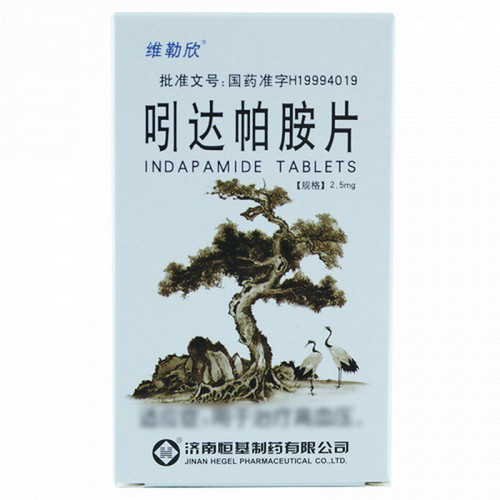Product Overview
[Drug Name]
Generic Name: Indapamide Tablets
Trade Name: Shourushong Indapamide Tablets 2.5mg x 30 Tablets
Pinyin Code: ZuoDaPaAnPian
[Main Ingredients]
Western Medicine
[Properties]
This product is a sugar-coated tablet, which appears white after removing the sugar coating.
[Indications/Main Functions]
This product is used to treat hypertension.
[Precautions]
1. To reduce the possibility of electrolyte imbalance, a smaller effective dose should be used. Regular monitoring of serum potassium, sodium, and uric acid levels should be performed to maintain fluid and electrolyte balance, and potassium supplementation should be performed promptly. 2. When used as a diuretic, it is best to administer the drug once daily in the morning to avoid having to urinate during the night. 3. Anuria or severe renal insufficiency may induce azotemia. 4. In diabetes, glucose tolerance may be impaired. 5. In patients with gout or hyperuricemia, serum uric acid may be further elevated. 6. In patients with hepatic insufficiency, diuresis may precipitate hepatic coma. 7. After sympathectomy, the antihypertensive effect may be enhanced. 8. If surgery is required while using this drug, it is not necessary to discontinue this drug, but the anesthesiologist must be informed.
[Drug Interactions]
Sulfonamide allergy, severe renal insufficiency, hepatic encephalopathy or severe hepatic insufficiency, and hypokalemia.
[Specifications]
2.5mg x 30 tablets (Shou Rusong)
[Dosage and Administration]
Adults: Take one tablet (2.5mg) once daily.
[Adverse Reactions]
Mild, transient, and dose-related. 1. Less common reactions include: diarrhea, headache, decreased appetite, insomnia, nausea, and orthostatic hypotension. 2. Less common reactions include: allergic reactions such as rash and itching; hyponatremia, hypokalemia, and hypochloremic alkalosis.
[Contraindications]
Sulfonamide allergy, severe renal insufficiency, hepatic encephalopathy or severe hepatic insufficiency, and hypokalemia.
[Overdose]
Unknown.
[Pharmacology and Toxicology]
1. This is a sulfonamide diuretic that works by inhibiting water and electrolyte reabsorption in the diluent segment of the distal renal tubular cortex. Its antihypertensive effect is unclear, and its diuretic effect cannot explain its antihypertensive effect because the dose at which it occurs is much lower than the dose at which it produces a diuretic effect. Possible mechanisms include: regulating calcium influx into vascular smooth muscle cells; stimulating the synthesis of prostaglandins PGE2 and PGI2; and reducing vascular hypersensitivity to vasopressors, thereby inhibiting vasoconstriction. 2. This drug has little or no effect on cardiac output, heart rate, and rhythm when used to lower blood pressure. Long-term use rarely affects glomerular filtration rate or renal blood flow. 3. This drug does not affect lipid and carbohydrate metabolism.
[Pharmacokinetics]
After oral administration, it is rapidly and completely absorbed, with a bioavailability of 93%, unaffected by food. Plasma binding is 71-79%, and it also binds to elastin in vascular smooth muscle. Peak plasma concentrations are reached 1-2 hours after oral administration. Peak antihypertensive effect occurs approximately 24 hours after a single oral dose; after repeated dosing, peak effect is achieved over approximately 8–12 weeks, with duration of effect lasting 8 weeks. The half-life is 14–18 hours. Metabolism occurs in the liver, producing 19 metabolites. Approximately 70% is excreted via the kidneys, 7% unchanged, and 23% via the gastrointestinal tract. Pharmacokinetic parameters are not altered in patients with renal failure.






